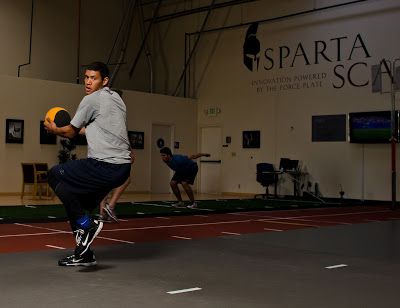The position of a quarterback is as demanding as any position in the world, combining the intellectual ability to adapt in an instant, the physical attributes of evading large defenders that run like track stars, and the emotional stability necessary for all great leaders of men. Yet there is one critical biomechanical characteristic, not only to stay healthy but to throw the ball harder and more accurately.

This vital movement is knee flexion, the ability to keep the legs slightly bent while stepping into the throw and rotating over that leg upon the release of the ball. While several NFL quarterback coaches and MVPs would agree with this obvious observation, only one large research study has examined the differences between high school and higher lever performers at the university level. This 2009 thesis out of the University of Manitoba measured over 30 variables on high speed cameras, as well as an extensive review on previous studies looking at overhead athletes, specifically football quarterbacks.
Since we know Ground Reaction Force (GRF) determines the results of all athletic movement, let’s start with the back leg first as it is responsible for loading and driving the body over the front leg. The review found higher level quarterbacks kept their back leg bent to allow hip extension rather than just knee extension. We previously discussed the hip’s role in power, being the largest weight bearing joint and therefore responsible for producing the most powerful movements. The greater use of the hips, by keeping the back leg bent, allow the quarterbacks to FULLY unweight the back foot at release due a powerful hip drive. We see this hip loading in athletes with high levels of DRIVE on the force plate.
These mechanics of the back leg has critical subsequent effects, particularly its ability to keep the front leg flexed. This front leg flexion allows the quarterback to fully transfer his weight over the front foot as the body rotates into the front hip pocket. Keeping both legs flexed allows the passer to flatten the path of the head, allowing the target to remain stationary and improve pass accuracy. Lower level quarterbacks try to compensate by increasing their trunk flexion, bending forward at the waist, which takes out the “whip”, the best structures that create and transfer force from the ground to the ball. This compensation also creates a lower release height, making the passes more susceptible to deflection.
We have talked about the hip power of the back leg and ensuing full weight transfer over the front leg, which all lead to the most important correlation in this study, step length. Previous authors have found the ideal step to be 4 to 6 inches, ideally to equal a throwing base that is 61% of a quarterback’s height. Again, knee flexion is key here because too large of a step will cause the front knee to straighten and lock out during the throw. Such over striding and knee straightening puts the quarterback at significant risk during contact from the defense.
Most coaches preach the quarterback’s footwork, especially in the passing pocket, but the real reason for this emphasis seems to be ensuring that both knees remain bent to maximize ball velocity, accuracy, and safety. Below is a great drill that encourages hip drive, but also landing on a flexed leg. WE have also added a medicine ball rotation to encourage upper back rotation found in all overhead sports, but specifically helps quarterbacks stay upright rather than bending at the waist.
MB Skater from SPARTA on Vimeo.
Since the mechanics are so intertwined, it is no accident that the most successful passing quarterbacks are the most likely to stay healthy.